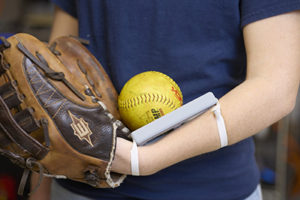 By Elan Lloyd.
By Elan Lloyd.
Photography by Yvette Gooden and Shawn Poynter.
Biomedical engineering senior Riley Toll came to college with a very specific plan. A congenital below-elbow amputee, she had a strong drive to gain the skills she would need to design and print her own prosthesis. Building on her high school knowledge of 3D printing, Toll immediately began learning CAD software in her first year at UT.

Sam Jurek, a junior civil and environmental engineering student, designed a life hack that allows upper-extremity amputees the ability to catch and throw a baseball or softball more easily.
Before long, she had printed a prosthetic hand and forearm with the help of a fellow engineering student, Alex Weber (EE ’20). However, the prosthesis proved to be uncomfortable and not terribly functional.
“It was really fun and a great learning experience, but the hand didn’t really do much,” she said.
She doesn’t think 3D-printed prosthetic devices are going to take off for those with upper-limb loss and limb differences like herself who don’t prefer to wear them, but she realized that many people still need assistance with some upper-extremity activities at times.
With the help of Professor Chad Duty, Erica Waters (ME ’20), and Kiana Hines (ME ’20), Toll and Weber started a club called Life Without Limits that would engage engineering students and others on campus to apply their skills to help the disability community with everyday activities.
“After realizing the challenges of printing a functional prosthetic device, we decided to pivot the group’s efforts into other ways we could help the disability community,” said Duty.
Soon the club was engaging with the amputee and limb loss community through Amputee Coalition, a national nonprofit organization. They began to learn about the creative solutions that people with upper limb loss and limb difference come up with to perform daily tasks such as tying shoes, using kitchen tools, playing musical instruments, and catching balls.

Hunter Potter, a senior in mechanical engineering, worked with another student, Daelyn Greene, to come up with a device meant to help stabilize items in the hand of a person with low mobility.
These solutions, commonly known as life hacks, often involve improvised materials like coat hangers and duct tape. The group quickly realized that it could help bridge the gap with engineered designs. In some cases, they provide the designs for free for others to 3D print on their own; in others, they print and mail finished products to customers.
“Engineers want to help people, but they can get kind of bogged down in the math and science demands of the curriculum—so this offers a creative outlet to meet customers, understand their problems, and design solutions for them,” said Toll.
Three years after the group was formed, it now has a dedicated maker space with state-of-the-art 3D printers managed by mechanical engineering senior Brandon Solsbee. The printing lab was made possible due to a generous donation from Professor of Practice Emeritus H. Lee Martin in the Department of Industrial and Systems Engineering.
Every month the group has a guest speaker so they can learn from people in the amputee community about the kinds of mobility challenges they face. For example, a recent meeting gave them a chance to learn about the daily life of a quadrilateral congenital amputee.
Students in the group focus on an area such as sports and recreation, hobbies, kitchen tasks, or toiletries. They even have the option of submitting their designs to the UT Research Foundation if they would like to get them patented.
“Since we aren’t trying to do prosthetic devices, there’s no fitting, no certification or other issues,” said Duty. “It’s just an upgrade on the coat hanger–duct tape solutions that people try to do themselves. It’s something that we can do for lots of different groups of people.”
LWL continues to work with the Amputee Coalition and will soon send prototypes of designs for beta testing to Camp Koinonia, a camp for individuals with disabilities that is hosted in partnership with the UT-based Therapeutic Recreation Experiential Education Team (TREES).
Hunter Potter, a senior in mechanical engineering, worked with another student, Daelyn Greene, to come up with a device meant to help stabilize items in the hand of a person with low mobility. It’s an intuitive device with a modular design that allows for different attachments to be used with a common wrist piece.
Although the prototype device was originally devised to hold a drumstick, the TREES staff said a camper at Camp Koinonia with low hand mobility had used it with a fork to feed himself.
Sam Jurek, a junior civil and environmental engineering student, designed a life hack that allows upper-extremity amputees the ability to catch and throw a baseball or softball more easily. Building on a glove transfer—an existing technique for baseball players with one arm—Jurek designed a ball track that attaches to the forearm and allows the ball to roll from the glove down the track to be held close to the body while the player takes the glove off to throw the ball. A player can perform the action seamlessly with some practice.
“This is a low entry barrier opportunity to actually make a really big difference,” said Duty.
Duty added that he hopes that Life Without Limits can continue to grow and provide students with hands-on experiences and direct exposure to the customers they are helping.